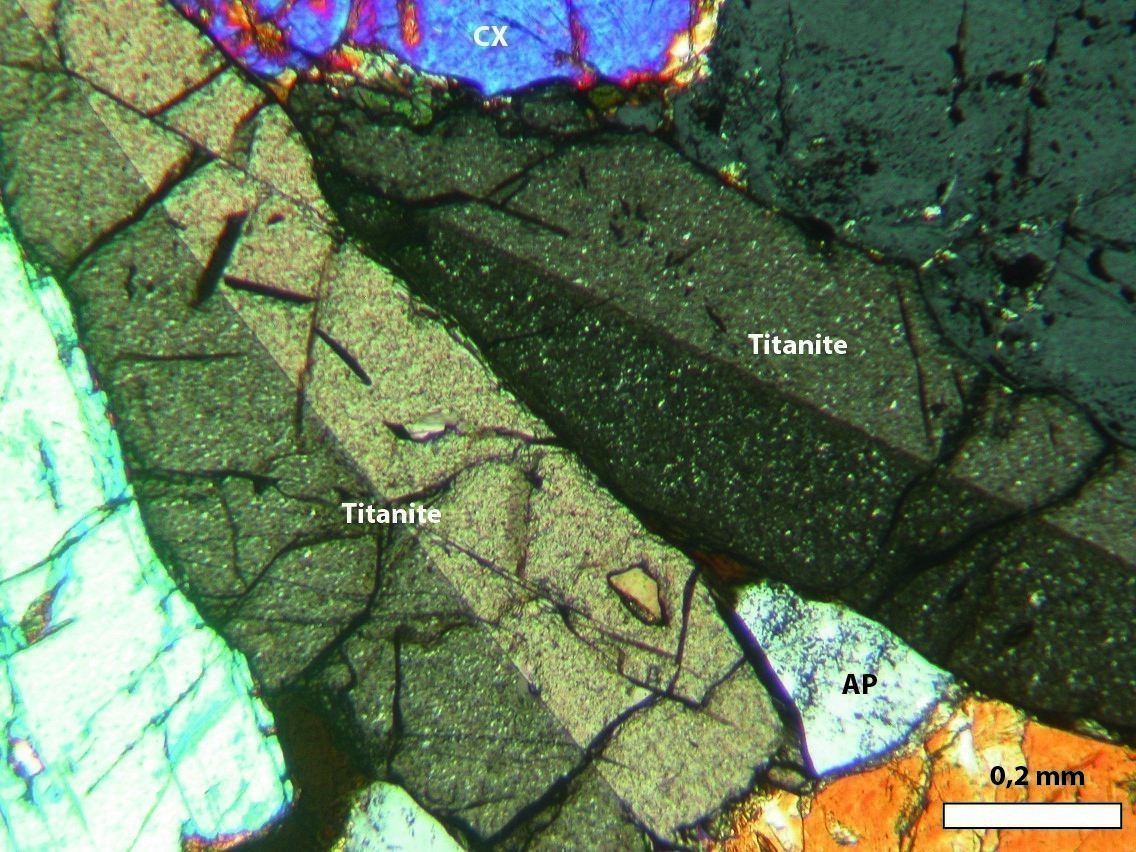
DISCLAIMER: This English version is translated from the original French. In case of any discrepancy, the French version shall prevail.
| Author(s): | El Bourki and Moukhsil, 2021 |
| Age: | Mesoproterozoic |
| Stratotype: | Reference outcrop 2021-GS-2094 |
| Type area: | West of the Noire River (SE corner of NTS sheet 32H01) |
| Geological province: | Grenville Province |
| Geological subdivision: | Allochton |
| Lithology: | Clinopyroxenite and syenite |
| Category: | Lithodemic |
| Rank: | Lithodeme |
| Status: | Formal |
| Use: | Active |
Background
The Rivière Noire Intrusion was defined by El Bourki and Moukhsil (2021) during mapping work in the areas north of Dolbeau-Mistassini (sheet 32H01), Girardville and Blondelas Lake (sheet 32H07), in the Saguenay–Lac-Saint-Jean region.
Description
The Rivière Noire Intrusion is an alkaline ultramafic intrusion consisting of clinopyroxenite and of syenite, alkali feldspar syenite and quartz syenite veins, veinlets and dykes. These syenitic facies are associated with clinopyroxenite and cannot be mapped at the scale of the mapping (1:50,000 scale) in the Dolbeau-Blondelas project (sheet 32H01). This intrusion is more or less easy to delineate on aeromagnetic maps (Intissar and Benahmed, 2015) and hosts a rare earth element mineralized zone discovered during the work of El Bourki and Moukhsil (2021; Aligas mineralized zone).
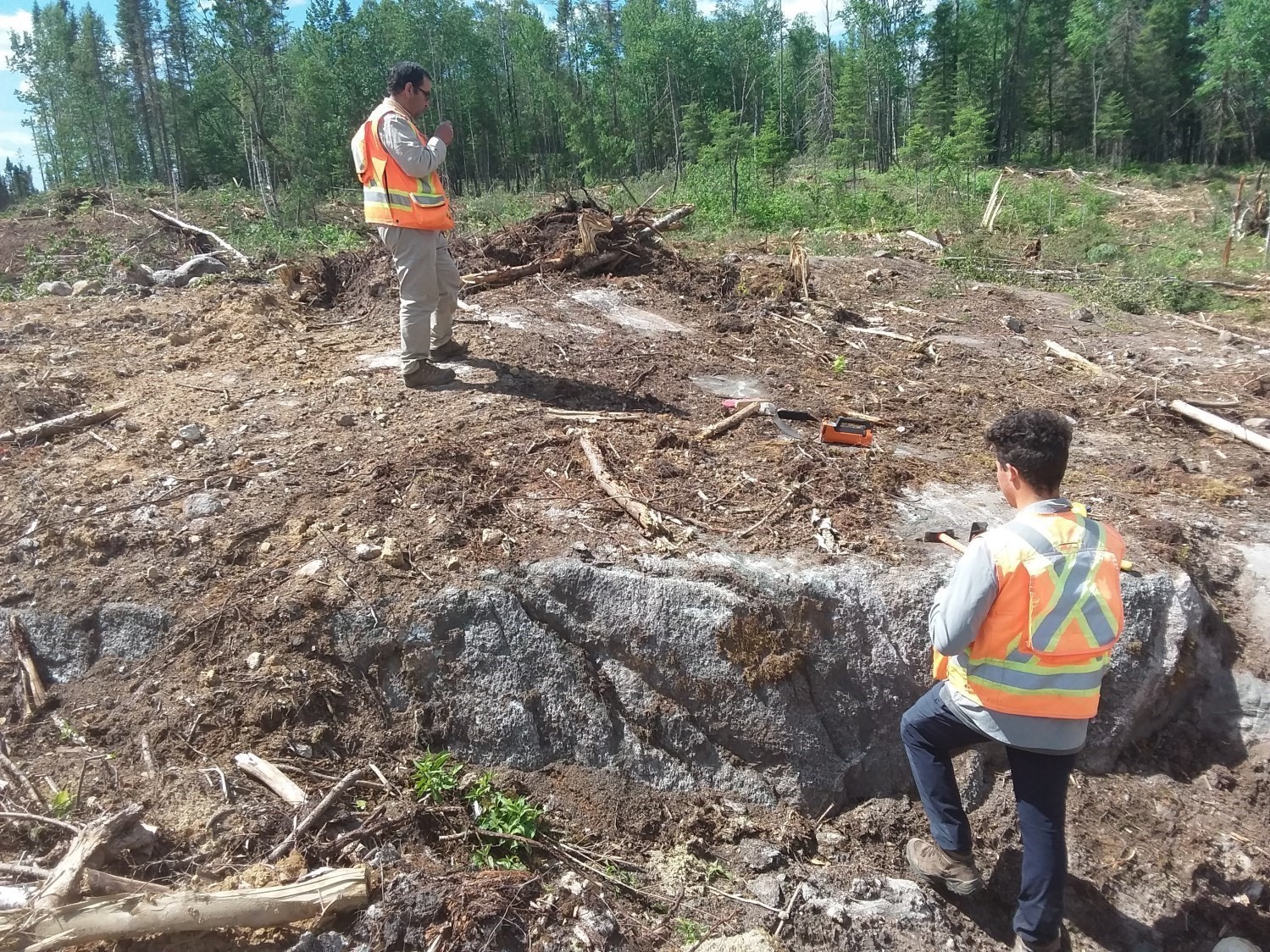
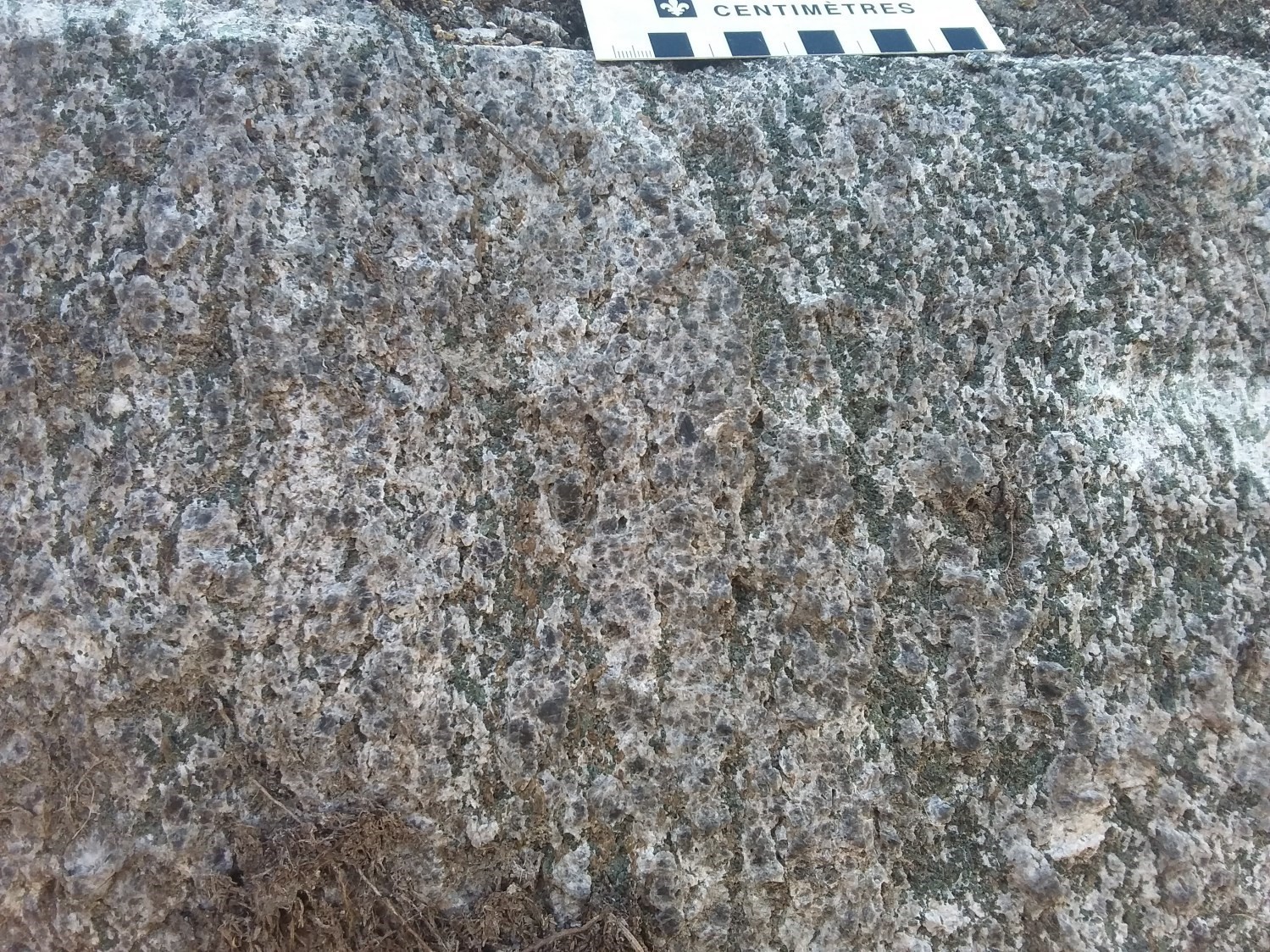
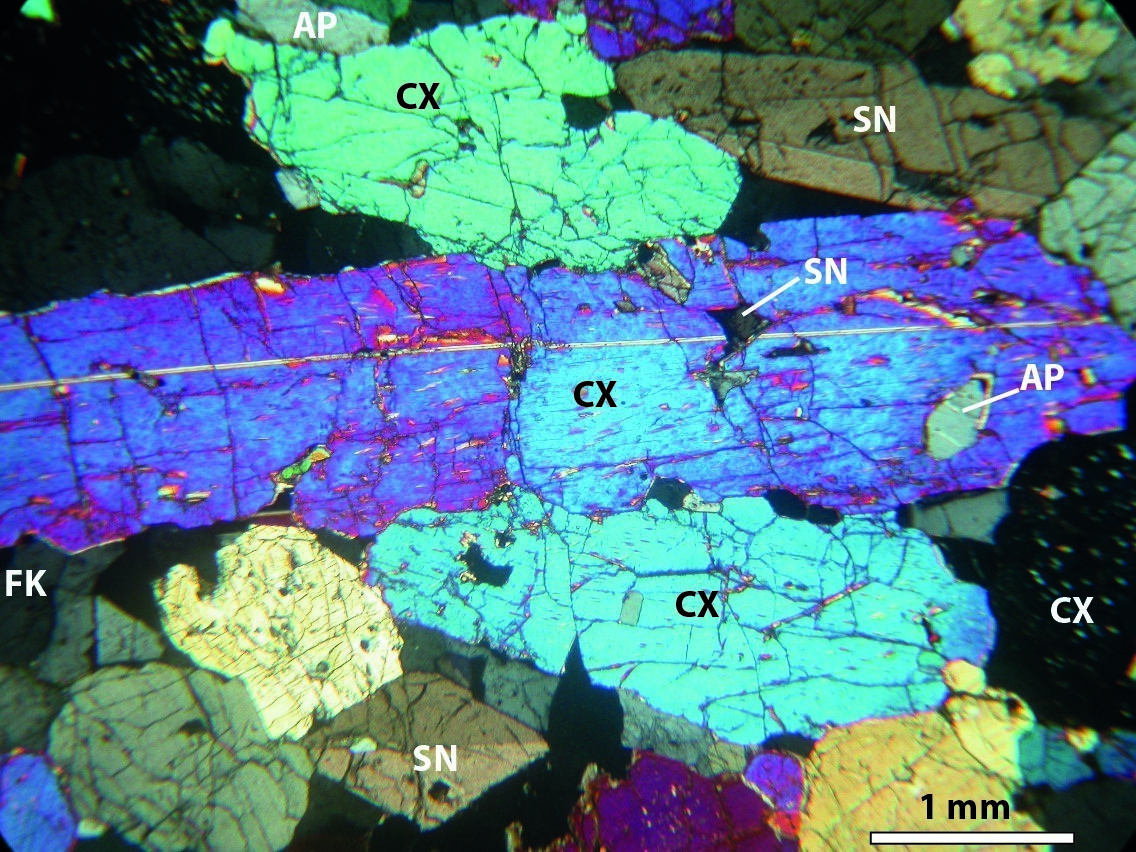
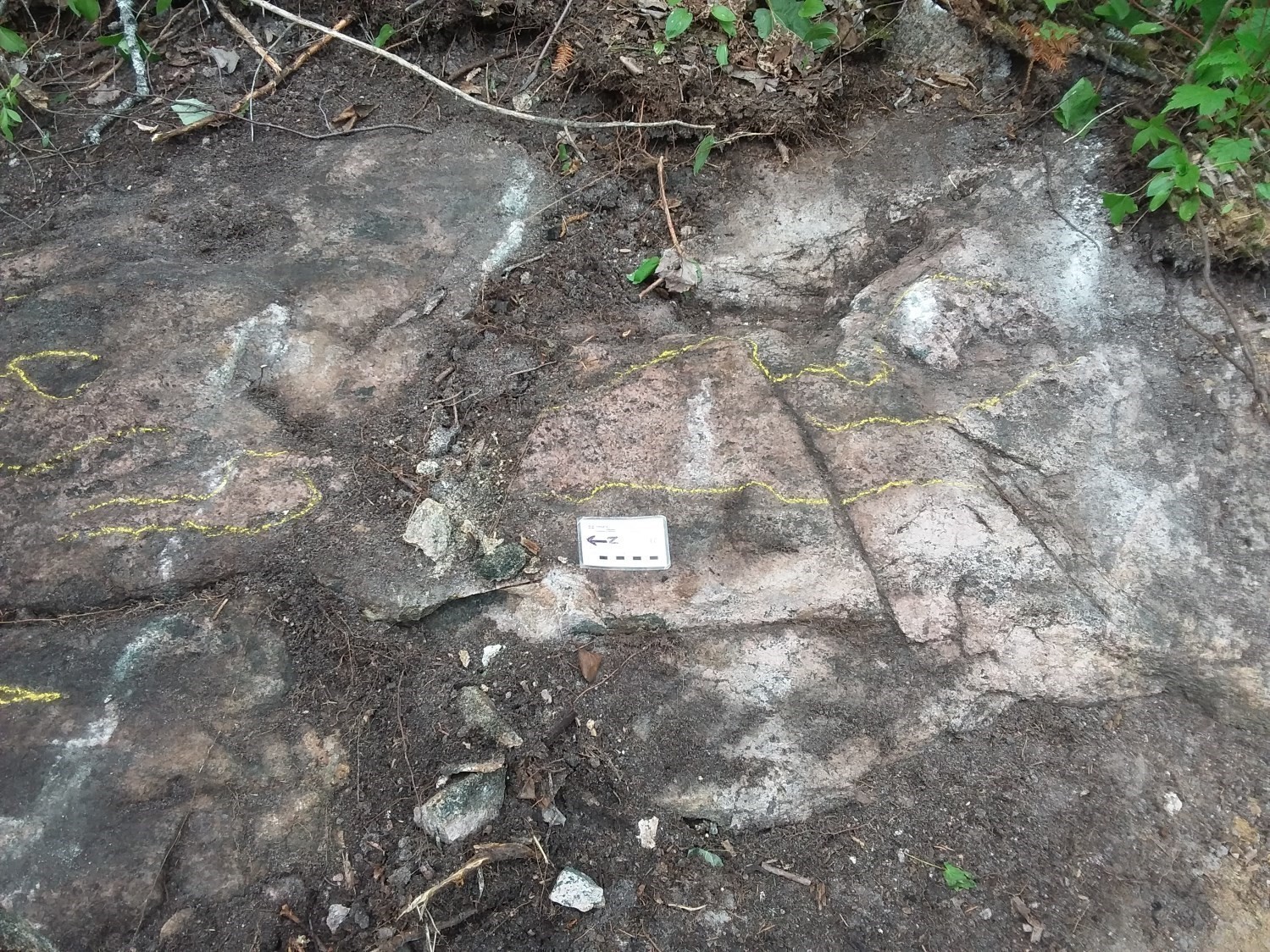 The main rock constituting this intrusion is a clinopyroxenite. It has a greenish alteration patina and a greenish-black to pinkish fresh surface (outcrop 2021-GS-2094). It is medium to coarse grained and locally porphyroid. It has a cumulate structure and it is slightly foliated. It consists of clinopyroxene (augite, >72%), titanite (4-8%), apatite (2-4%), potassium feldspar (10-15%), calcite (<1%), olivine (<1%) and traces of orthopyroxene, quartz, magnetite and zircon. The clinopyroxenite is cut by veins, veinlets and dykes of syenite, alkali feldspar syenite and quartz syenite. The clinopyroxenite appears recrystallized and the associated syenitic phases appear foliated and deformed. Some evidence of syenitic and ultramafic magmas mixing is locally highlighted in the intrusion by diffuse contacts between the two magmas.
The main rock constituting this intrusion is a clinopyroxenite. It has a greenish alteration patina and a greenish-black to pinkish fresh surface (outcrop 2021-GS-2094). It is medium to coarse grained and locally porphyroid. It has a cumulate structure and it is slightly foliated. It consists of clinopyroxene (augite, >72%), titanite (4-8%), apatite (2-4%), potassium feldspar (10-15%), calcite (<1%), olivine (<1%) and traces of orthopyroxene, quartz, magnetite and zircon. The clinopyroxenite is cut by veins, veinlets and dykes of syenite, alkali feldspar syenite and quartz syenite. The clinopyroxenite appears recrystallized and the associated syenitic phases appear foliated and deformed. Some evidence of syenitic and ultramafic magmas mixing is locally highlighted in the intrusion by diffuse contacts between the two magmas.
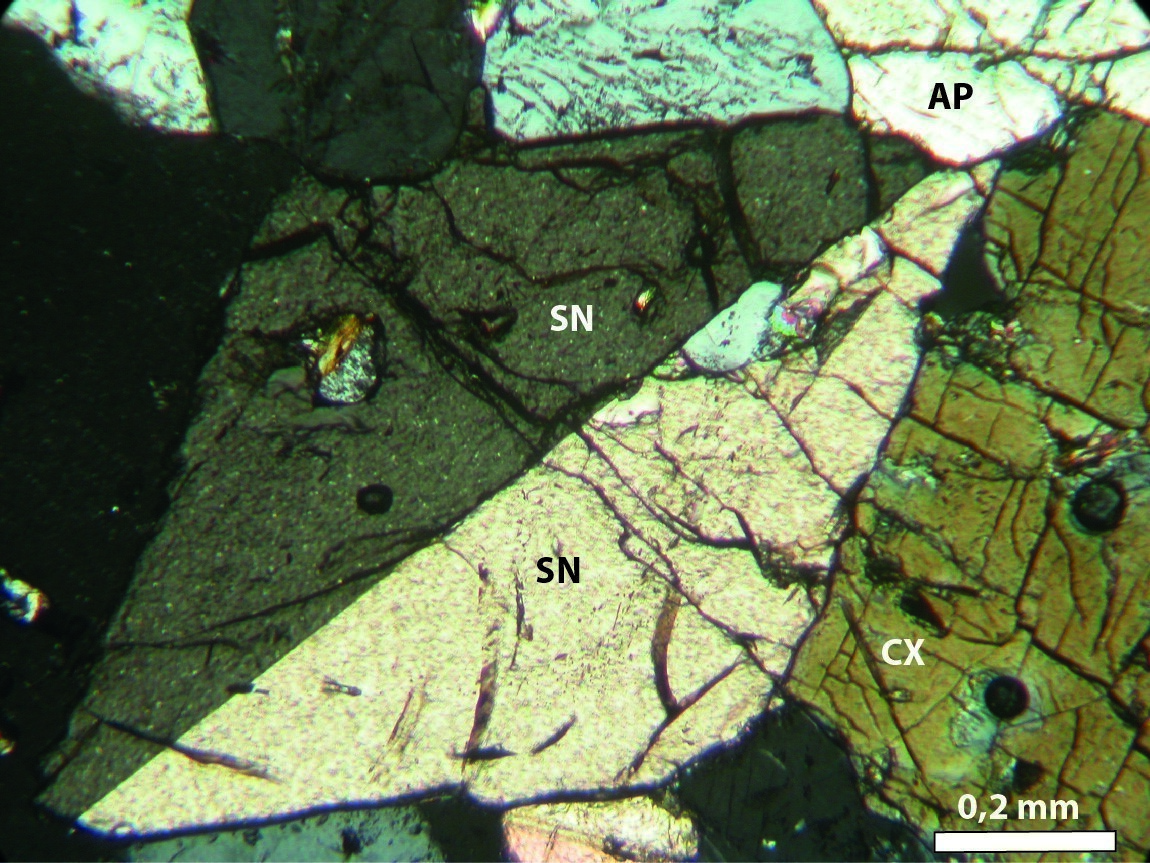
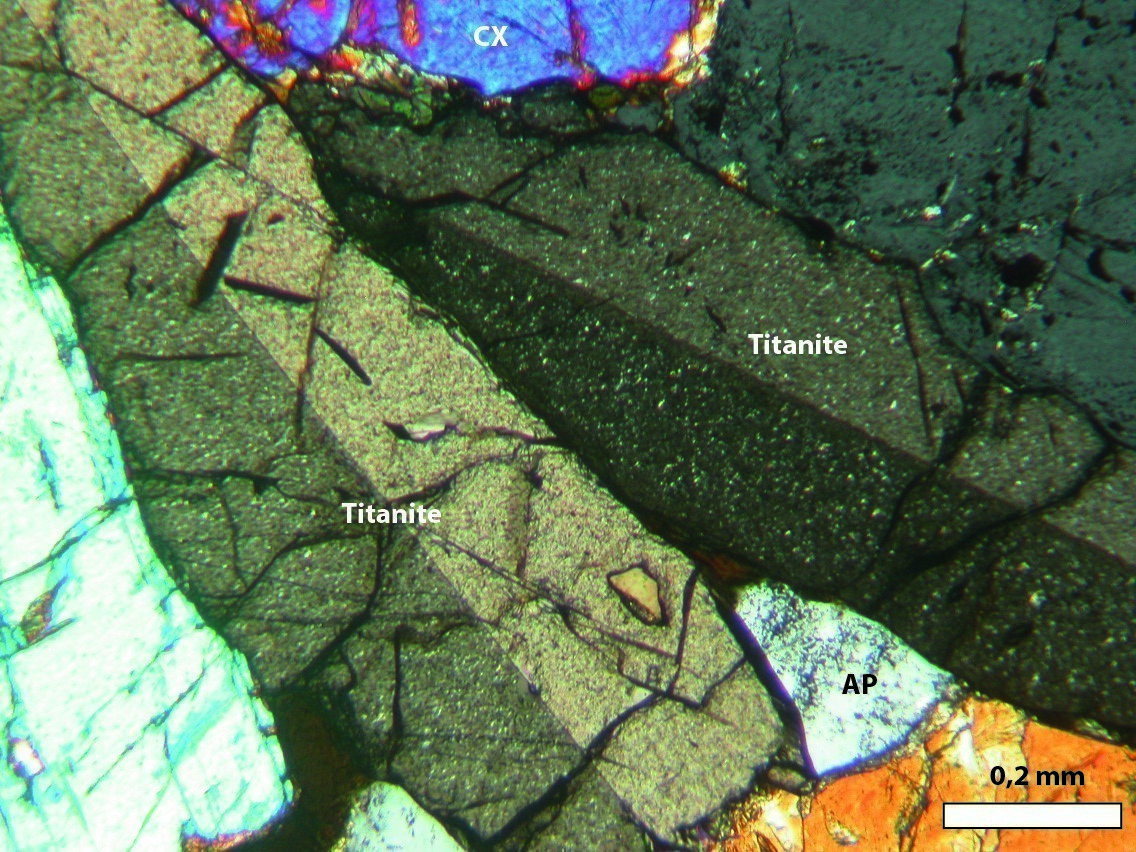 Clinopyroxenite contains titanite which can reach 2 cm in length and, under the microscope, shows a typical twinned crystal with a strong positive relief. This titanite is observed as crystals between other minerals as well as inclusions within clinopyroxene and potassium feldspar. The size of the apatite is <0.3 cm, while clinopyroxene rods exceed 1.5 cm. X-ray microdiffraction (µXRF) maps show the different chemical elements and the association of minerals forming clinopyroxenite.
Clinopyroxenite contains titanite which can reach 2 cm in length and, under the microscope, shows a typical twinned crystal with a strong positive relief. This titanite is observed as crystals between other minerals as well as inclusions within clinopyroxene and potassium feldspar. The size of the apatite is <0.3 cm, while clinopyroxene rods exceed 1.5 cm. X-ray microdiffraction (µXRF) maps show the different chemical elements and the association of minerals forming clinopyroxenite.
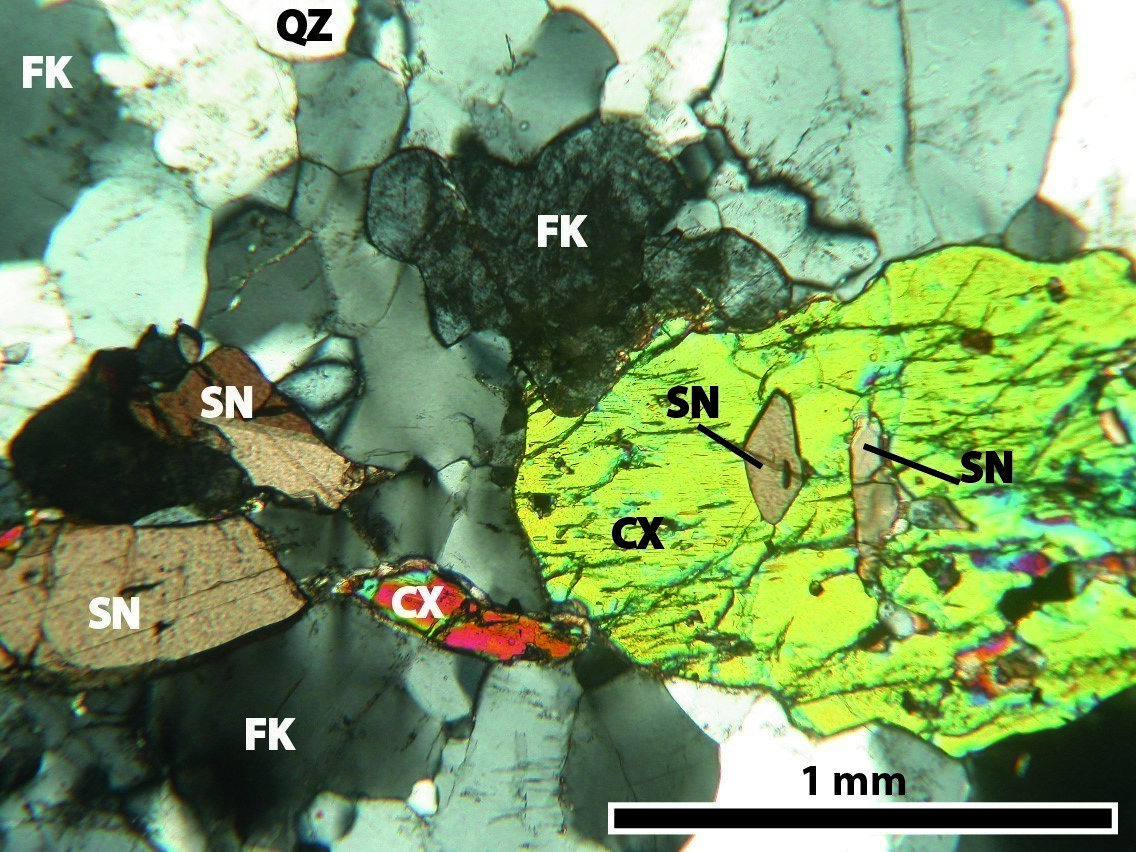
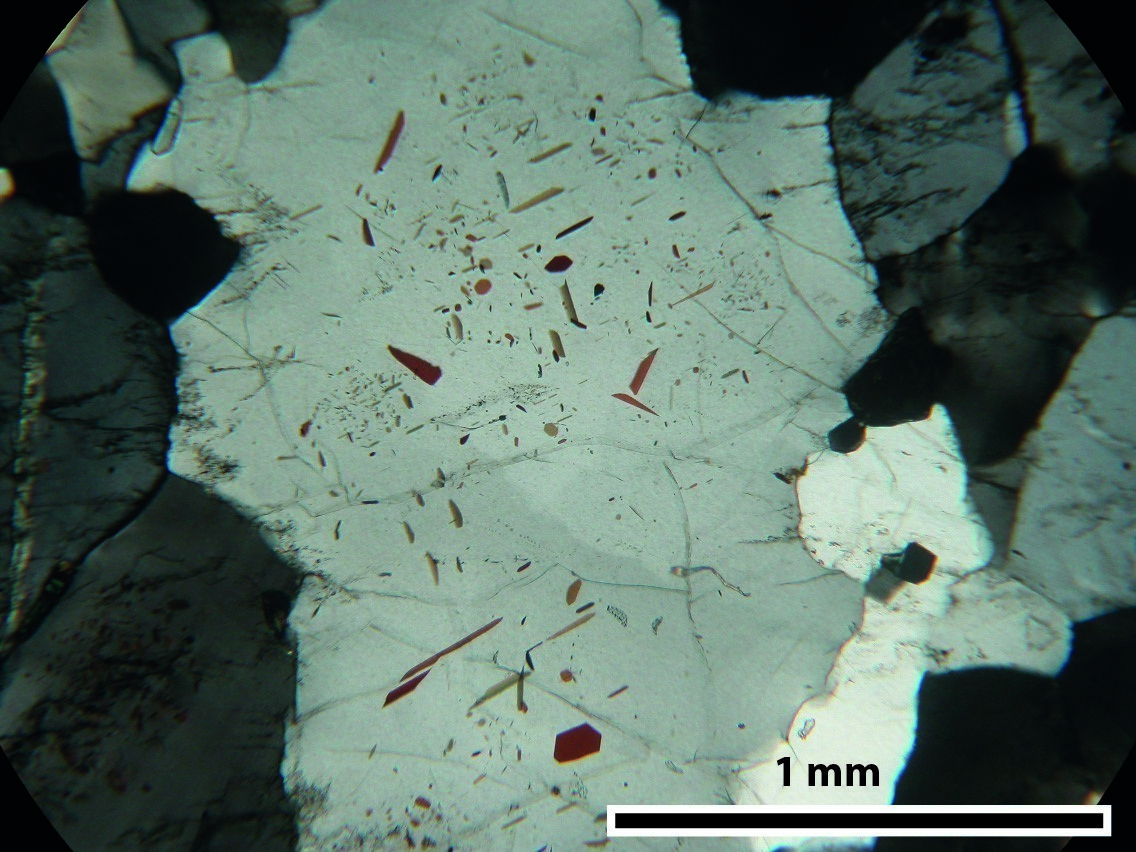 Alkali feldspar syenite is pink-green in fresh and altered surfaces, medium to coarse grained and locally porphyroid with potassium feldspar phenocrysts (e.g., outcrop 2021-GS-2093). The syenite consists of greenish clinopyroxene, potassium feldspar, titanite, apatite and opaque minerals along with traces of orthopyroxene. Clinopyroxene (1-5%, up to 1 cm in length) is seen in isolated crystals and in decimetric clusters. Under the microscope, titanite (2-5% of the rock) is seen as isolated crystals here and there in the rock and as inclusions in clinopyroxene. The potassium feldspar is devoid of typical twinning and reaches 5 cm in length. It is generally enriched with several micrometric inclusions of acicular rutile and other unidentified minerals. The alkali feldspar syenite contains centimetric enclaves of clinopyroxenite.
Alkali feldspar syenite is pink-green in fresh and altered surfaces, medium to coarse grained and locally porphyroid with potassium feldspar phenocrysts (e.g., outcrop 2021-GS-2093). The syenite consists of greenish clinopyroxene, potassium feldspar, titanite, apatite and opaque minerals along with traces of orthopyroxene. Clinopyroxene (1-5%, up to 1 cm in length) is seen in isolated crystals and in decimetric clusters. Under the microscope, titanite (2-5% of the rock) is seen as isolated crystals here and there in the rock and as inclusions in clinopyroxene. The potassium feldspar is devoid of typical twinning and reaches 5 cm in length. It is generally enriched with several micrometric inclusions of acicular rutile and other unidentified minerals. The alkali feldspar syenite contains centimetric enclaves of clinopyroxenite.
Veins, veinlets and dykes of syenite and quartz syenite are pink in fresh surface and pink-green in alteration patina. The rock is medium grained and porphyroid or granoblastic. In thin sections, the main minerals are potassium feldspar in phenocrysts, locally perthitic and with Scottish kilt type twinning, clinopyroxene and quartz. Clinopyroxene crystals are grouped in irregular clusters throughout the rock. Accessory minerals include apatite, opaque minerals (pyrite and pyrrhotite) and titanite, the latter (<1% of the rock) occurring as isolated crystals and inclusions, mostly in the potassium feldspar.
Thickness and distribution
The Rivière Noire Intrusion is elliptical and has an area of ~15 km². It is located between the Crevier Alkaline Intrusion and the carbonatite of the Saint-Honoré Complex. This complex is emplaced south of the Waswanipi-Saguenay Zone. This zone (or corridor) constitutes a major lineament from the Superior Province to the Saguenay (Moorhead et al., 1999). It includes, among others, the Montviel (1894.2 ±3.5 Ma, David et al., 2006; Goutier, 2006) and Lac Shortt (2652 Ma, Morasse, 1988 in Nadeau et al., 2014) carbonatites in the Superior Province and the Saint-Honoré (582.2 ±1.8 Ma, in Néron et al., 2018) carbonatite in the Grenville Province. A second zone (Nottaway) contains the Dolodau carbonatite dykes (2631 ±8 Ma; Bedard and Chown, 1992). The Crevier Alkaline Intrusion carbonatite (957 ±2.9 Ma, Groulier et al., 2020) is located slightly away from these two zones, but is still aligned with the Rivière Noire Intrusion and the Saint-Honoré Complex carbonatite.
Dating
None.
Stratigraphic Relationship(s)
The Rivière Noire Intrusion cuts the Lac-Saint-Jean Anorthositic Suite and the Saint-Onge Supracrustal Sequence. It is in turn injected by veins, veinlets and dykes of syenite, alkali feldspar syenite and quartz syenite assigned to this same intrusion.
Paleontology
Does not apply.
References
Publications available through SIGÉOM Examine
DAVID, J., DION, C., GOUTIER, J., ROY, P., BANDYAYERA, D., LEGAULT, M., RHÉAUME, P., 2006. Datations U-Pb effectuées dans la Sous-province de l’Abitibi à la suite des travaux de 2004-2005. MRNF, GÉOTOP UQAM-MCGILL; RP 2006-04, 22 pages.
EL BOURKI, M., MOUKHSIL, A., 2021. Géologie de la région de Dolbeau-Blondelas, Province de Grenville, région du Saguenay–Lac-Saint-Jean, Québec, Canada. MERN; BG 2022-02, 1 plan.
INTISSAR, R., BENAHMED, S. 2015. LEVÉ MAGNÉTIQUE AÉROPORTÉ DANS LE SECTEUR OUEST DU LAC-ST-JEAN, PROVINCE DE GRENVILLE. MERN, GOLDAK AIRBORNE SURVEYS; DP 2015-06, 7 pages and 2 plans.
GOUTIER, J., 2006. Géologie de la région du lac au Goéland (32/F15). MRNF RG 2005-05, 44 pages and 4 plans.
MOORHEAD, J., BEAUMIER, M., LEFEBVRE, D. L., BERNIER, L., MARTEL, D., 1999. KIMBERLITES, LINÉAMENTS ET RIFTS CRUSTAUX AU QUÉBEC. MRN; MB 99-35, 129 pages, 1 plan.
Other publications
BÉDARD, L.P., CHOWN, E.H., 1992. The Dolodau dykes, Canada: An example of an Archean carbonatite. Mineralogy and Petrology; volume 46, pages 109-121. doi.org/10.1007/BF01160181
GROULIER, P.A., TURLIN, F., ANDRÉ-MAYER, A.S., OHNENSTETTER, D., CRÉPON, A., BOULVAIS, P., POUJOL, M., ROLLION-BARD, C., ZEH, A., MOUKHSIL, A., SOLGADI, F., EL BASBAS, A., 2020. Silicate-Carbonate Liquid Immiscibility: Insights from the Crevier Alkaline Intrusion (Quebec). Journal of Petrology; volume 61, issue 3. doi.org/10.1093/petrology/egaa033
MORASSE, S., 1988. Geological setting and evolution of the Lac-Shortt gold deposit, Waswanipi, Quebec, Canada. Queen’s University, Kingston, Ontario; Master’s thesis, 221 pages.
NADEAU, O., STEVENSON, R., JÉBRAK M., 2014. The Archean magmatic-hydrothermal system of Lac Shortt (Au-REE), Abitibi, Canada: Insights from carbonate fingerprinting. Chemical Geology; volume 387, pages 144-156. doi.org/10.1016/j.chemgeo.2014.08.021
NÉRON, A, BÉDARD, L.P., GABOURY, D., 2018. The Saint-Honoré Carbonatite REE Zone, Québec, Canada: Combined Magmatic and Hydrothermal Processes. Minerals; volume 8, 397, 19 pages. doi.org/10.3390/min8090397
Suggested Citation
Ministère de l’Énergie et des Ressources naturelles (MERN). Rivière Noire Intrusion. Quebec Stratigraphic Lexicon. https://gq.mines.gouv.qc.ca/lexique-stratigraphique/province-de-grenville/intrusion-de-riviere-noire_en [accessed on Day Month Year].
Contributors
|
First publication |
Abdelali Moukhsil, P.Geo., Ph.D. abdelali.moukhsil@mern.gouv.qc.ca; Mhamed El Bourki, GIT, M.Sc. mhamed.elbourki@mern.gouv.qc.ca (redaction) Mehdi A. Guemache, P.Geo., Ph.D. (coordination); Fabien Solgadi, P.Geo., Ph.D. (critical review); Simon Auclair, P.Geo., M.Sc. (editing); Catherine Tremblay (English version). |

